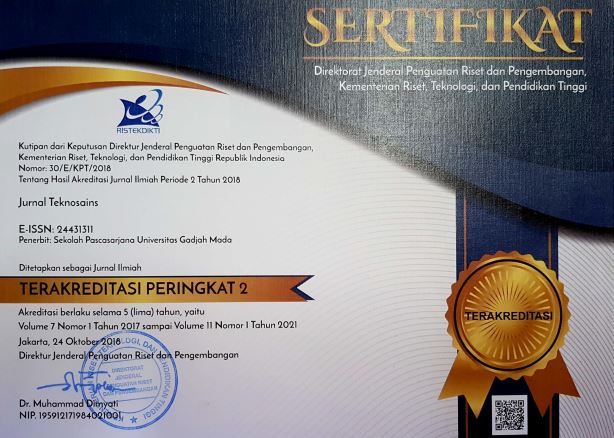Rasio natrium karbonat dalam ekstraksi berpengaruh pada mutu natrium alginat sargassum muticum
Sovia Indah Nurkhanifah(1), Amir Husni(2*)
(1)
(2) Scopus ID: 37117167000, Departemen Perikanan, Fakultas Pertanian, Universitas Gadjah Mada, Jl. Flora A4 Bulaksumur, Yogyakarta 55281
(*) Corresponding Author
Abstract
Keywords
Full Text:
PDFReferences
Anonim. 2013. Volume Produksi Kerapu-Rumput Laut-Nila 2009-2013. Data Statistik Perikanan. Jakarta.
AOAC. 1995. Official Method of Analysist of The Association of Official Analytical of Chemyst. Arlington, Virginia. Published by The Association of Official Analytical Chemyst, Inc. USA.
Aristya, I.M.T.W., B. Admadi., dan I. W. Arnata. 2017. Karakteristik Mutu dan Rendemen Alginat dari Ekstrak Rumput Laut Sargassum Sp. dengan Menggunakan Larutan Asam Asetat. Jurnal Rekayasa Dan Manajemen Agroindustri 5(1):81-92.
Bahar, R., A. Arief, dan Sukriadi. 2012. Daya Hambat Ekstrak Na-alginat dari Alga Cokelat Jenis Sargassum sp. terhadap Proses Pematangan Buah Mangga dan Buah Jeruk Indonesia. Chimica Acta 5(2): 22-31.
Cottrell, I. W. dan P. Konvacs. 1980. Alginats. In Davidson R.L, (ed). Hand Book of Water Soluble Gums and Resin. McGraw-Hill Book Co, New York.
Darmawan, M., Tazwir dan N. Hak. 2006. Pengaruh Perendaman Rumput Laut Cokelat Segar dalam Berbagai Larutan Terhadap Mutu Natrium Alginat. Buletin Teknologi Hasil Perikanan 9(1): 26-38.
Davis, T. A., F. Llanes., B. Volesky, dan A. Mucci. 2003. Metal Selectivity of Sargassum spp. and Their Alginats In Relation to Their α-L-Guluronic Acid Content and Conformation. Environmental Science and Technology 37(2): 261-267.
Finotelli, P. V., D.A. Sampaio., M.A. Morales., A.M. Rossi, dan M.H. Rocha-Leao. 2008. Ca Alginat as Scaffold for Iron Oxide Nanoparticles Synthesis. Brazil. Journal Chemical Enggineering 25(4): 759-764.
Husni, A., Subaryono., Y. Pranoto, Tazwir, dan Ustadi. 2012. Pengembangan Metode Ekstraksi Alginat Dari Rumput Laut Sargassum sp. Sebagai Bahan Pengental. Agritech 32 (1): 1-8.
Hutching, J.B. 1999. Food Color and Appearance. 2nd ed. A Chapman and Hall Food Science Book, an Aspen Publ.
Gaithersburg, Maryland. Jayanudin., A.Z. Lestari, dan F. Nurbayanti. 2014. Pengaruh Suhu dan Rasio Pelarut Ekstraksi Terhadap Rendemen dan Viskositas Natrium Alginat Dari Rumput Laut Cokelat (Sargassum sp). Jurnal Integrasi Proses 5(1): 51-55.
Ju, H.K., S.Y. Kim., S.J. Kim, dan Y.M. Lee. 2002. PH/Temperature-Responsive Semi-IPN Hydrogels Composed of Alginat and Poly (N-Isopropylacrylamide). Journal Of Applied Polymer Science 83(3): 1128-1139.
Junaidi, R.R. 2006. Kajian Penggunaan NaOCl dan Kaporit pada Pemucatan Natrium Alginat dari Rumput Laut Cokelat. Skripsi. Fakultas Teknologi Pertanian Institut Pertanian Bogor. Bogor.
Leal, D., B. Matsuhiro., M. Rossi, dan F. Caruso. 2008. FT-IR Spectra of Alginic Acid Block Franctions in Three Species of Brown Seaweeds. Carbohydrate Research 343: 308-316.
Mazumder, A., S.L. Holdt, dan D.D. Francisci. 2016. Ekstraction of Alginat From Sargassum muticum: Process Optimization and Study of Its Functional Activities. J Appl Phycol 28(6): 3625-3635
McHugh, D.J. 1987. Production, Properties and Uses of Alginat, In: D. J. McHugh (ed.) Production and Utilization of Productsfrom Commercial Seaweeds. Food and Agriculture Organization of the United Nations.
Rome. Mushollaeni, W, dan E. Rusdiana. 2011. Karakterisasi Natrium Alginat Dari Sargassum sp., Turbinaria sp., dan Padina sp. J. Teknol. dan Industri Pangan 22(1):26-32.
Nurkhanifah, S.I. 2018. Pengaruh Rasio Na2CO3 Dalam Estraksi terhadap Mutu Natrium Alginat dari Sargassum muticum (Yendo) Fensholt. Skripsi. Departemen Perikanan Fakults Pertanian Universitas Gadjah Mada. Yogyakarta.
Omar, S., N. Ahmad, dan F. Ahmad.1988. Composition of Alginats from Brown Seaweeds, Sargassum and Padina spp. Journal of Pertanika 11(1):79-85.
Rasyid, A. 2003. Alga Cokelat (Phaeophyta) Sebagai Sumber Alginat. Oseana 28(1):33-38. Rasyid, A. 2010. Ekstraksi Natrium Alginat dari Alga Cokelat Sargassum echinocarphum. Oseanologi dan Limnologi di Indonesia 36(3): 393-400.
Sa’adah, N. 2017. Pengaruh Metode Presipitasi dalam Ekstraksi Terhadap Mutu Natrium Alginat dari Rumput Laut Cokelat (Sargassum muticum (Yendo) Fensholt, 1955). Skripsi. Departemen Perikanan Fakultas Pertanian Universitas Gadjah Mada. Yogyakarta.
Silverstein, R.M. 1991. Spectrometric Identification of Organic Compounds. John Wiley and Sons Inc. New York. Subaryono. 2010. Modifikasi Alginat dan Pemanfaatan Produknya. Jurnal Squalen. 5(1): 1-7.
Sukma, I.W.A., B.A. Harsojuwono, dan I.W Arnata. 2017. Pengaruh Suhu dan Lama Pemanasan Ekstraksi terhadap Rendemen dan Mutu Alginat dari Rumput Laut Hijau Sargassum sp. Jurnal Rekayasa dan Manajemen Agroindustri 5(1):71-80.
Susanto, T., Zailanie, K., dan Simon, BW., 2001, Ekstrasi dan Pemurnian Alginat Dari Sargassum filinpendula Kajian Dari Bagian Tanaman, Lama Ekstraksi Dan Konsentrasi Isopropanol. J. Teknologi Pertanian 2(1): 10-27.
Taylor, W.R. 1979. Marine Algae of The Eastern Tropical and Subtropical Coasts of the Americas. The University of Michigan Press. America.
Wedlock, D. J. dan B. A. Fasihuddin. 1990. Effect of Formaldehyde Pre-treatment on The Intrinsic Viscosity of Alginat From Various Brown Seaweeds. Journal of Food Hydrocolloids 4(1):41-47.
Wibowo, A., A. Ridlo, dan S. Sedjati. 2013. Pengaruh Suhu Ekstraksi Terhadap Kualitas Alginat Rumput Laut Turbinaria sp. dari Pantai Krakal, Gunung Kidul-Yogyakarta. Journal of Marine Research 2(3): 15-24.
Winarno, F.G. 1990. Teknologi Pengolahan Rumput Laut. Pustaka Sinar Harapan. Jakarta.
Yudiati, E dan A. Isnansetyo. 2016. Characterizing the Three Different Alginate Type of Sargassum siliquosum. Ilmu Kelautan 22(1): 7-14.
Zailanie, K., T. Susanto, dan B.W. Simon. 2001. Ekstraksi dan Pemurnian Alginat dari Sargassum filipendula Kajian dari Bagian Tanaman, Lama Ekstraksi dan Konsentrasi Isopropanol. Jurnal Teknologi Pertanian 20(1): 10-27.
Article Metrics
Refbacks
- There are currently no refbacks.
Copyright (c) 2019 Amir Husni

This work is licensed under a Creative Commons Attribution-ShareAlike 4.0 International License.
Copyright © 2024 Jurnal Teknosains Submit an Article Tracking Your Submission
Editorial Policies Publishing System Copyright Notice Site Map Journal History Visitor Statistics Abstracting & Indexing










